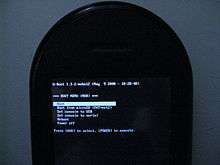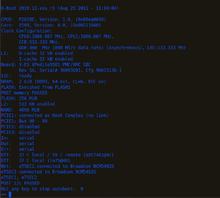Das U-Boot
| Developer(s) | DENX Software Engineering |
|---|---|
| Initial release | October 15, 1999 |
| Stable release |
v2016.05
/ May 16, 2016 |
| Preview release |
v2016.07-rc1
/ June 6, 2016 |
| Development status | active |
| Written in | C |
| Available in | English |
| Type | Boot loader |
| License | GNU GPLv2+ |
| Website |
www |
Das U-Boot (subtitled "the Universal Boot Loader" and shortened to "U-Boot") is an open source, primary boot loader used in embedded devices to package the instructions to boot the device's operating system kernel. It is available for a number of computer architectures, including 68k, ARM, AVR32, Blackfin, MicroBlaze, MIPS, Nios, SuperH, PPC and x86.
Functionality
U-Boot is both a first-stage and second-stage bootloader. It is loaded by the system's ROM or BIOS from a supported boot device. These vary by platform; typical examples include SD cards, SATA, NOR flash (e.g. EEPROMs, using SPI or I²C), and NAND flash. If there are size constraints, U-Boot may be split into stages: the platform would load a small SPL (Secondary Program Loader), and the SPL would do initial hardware configuration and load the rest of U-Boot.[1][2][3] Regardless of whether the SPL is used, U-Boot performs both first-stage (e.g., configuring memory controllers and SDRAM) and second-stage booting (performing multiple steps to load a modern operating system from a variety of devices that must be configured, presenting a menu for users to interact with and control the boot process, etc.).
U-Boot runs a command-line interface on a serial port. Using the console, users can load and boot a kernel, possibly changing parameters from the default. There are also commands to read device information, read and write flash memory, download files (kernels, boot images, etc.) from the serial port or network, manipulate device trees, and work with environment variables (which can be written to persistent storage, and are used to control U-Boot behavior such as the default boot command and timeout before auto-booting, as well as hardware data such as the Ethernet MAC address).
Unlike PC bootloaders which obscure or automatically choose the memory locations of the kernel and other boot data, U-Boot requires its boot commands to explicitly specify the memory addresses as destinations for copying data (kernel, ramdisk, device tree, etc.) and for jumping to the kernel and as arguments for the kernel. Because U-Boot's commands are fairly low-level, it takes several steps to boot a kernel, but this also makes U-Boot more flexible than other bootloaders, since the same commands can be used for more general tasks. It's even possible to upgrade U-Boot using U-Boot, simply by reading the new bootloader from somewhere (local storage, or from the serial port or network) into memory, and writing that data to persistent storage where the bootloader belongs.
U-Boot has support for USB, so it can use a USB keyboard to operate the console (in addition to input from the serial port), and it can access and boot from USB Mass Storage devices such as SD card readers.
Boot sources
(Note: These are boot sources that U-Boot is capable of loading data (i.e. a kernel) from. U-Boot itself must be booted by the platform, and that must be done from a device that the platform's ROM or BIOS is capable of booting from, which naturally depends on the platform.)
- Onboard storage
- SD card
- SATA
- NAND flash
- USB
- Serial port (file transfer)
- Network boot (optionally using DHCP, BOOTP, or RARP)
Compatible file systems
Device tree
Device tree is a data structure for describing hardware layout. Using Device tree, a vendor might be able to use an unmodified mainline U-Boot on otherwise special purpose hardware. As also adopted by the Linux kernel, Device tree is intended to ameliorate the situation in the embedded industry, where a vast number of product specific forks (of U-Boot and Linux) exist. The ability to run mainline software practically gives customers indemnity against lack of vendor updates.
History


The project's origin is a 8xx PowerPC bootloader called 8xxROM written by Magnus Damm.[4] In October 1999 Wolfgang Denk moved the project to SourceForge.net and renamed it to PPCBoot, because SF.net did not allow project names starting with digits.[4] Version 0.4.1 of PPCBoot was first publicly released July 19, 2000.
In 2002 a previous version of the source code was briefly forked into a product called ARMBoot, but was merged back into the PPCBoot project shortly thereafter. On October 31, 2002 PPCBoot−2.0.0 was released. This marked the last release under the PPCBoot name, as it was renamed to reflect its ability to work on other architectures besides the PPC ISA.[5][6]
PPCBoot−2.0.0 became U−Boot−0.1.0 in November 2002, expanded to work on the x86 processor architecture. Additional architecture capabilities were added in the following months: MIPS32 in March 2003, MIPS64 in April, Altera NIOS−32 in October, Coldfire in December, and Microblaze in April 2004. The May 2004 release of U-Boot-1.1.2 worked on the products of 216 board manufacturers across the various architectures.[6]
The current name Das U-Boot adds a German definite article, to create a bilingual pun on the German word for "submarine." It is free software released under the terms of the GNU General Public License. It can be built on an x86 PC for any of its intended architectures using a cross development GNU toolchain, for example crosstool, the Embedded Linux Development Kit (ELDK) or OSELAS.Toolchain.
The importance of U-Boot in embedded Linux systems is quite succinctly stated in the book Building Embedded Linux Systems, by Karim Yaghmour, whose text about U-Boot begins, "Though there are quite a few other bootloaders, 'Das U-Boot,' the universal bootloader, is arguably the richest, most flexible, and most actively developed open source bootloader available."[7]
Usages
- The ARM-based Chromebooks ship with U-Boot. The Celeron- and i5-based Chromebooks use it as payload for coreboot.[8]
- The PowerPC based series of AmigaOne computers running AmigaOS use U-Boot, in particular the Sam440ep and Sam460ex by ACube Systems Srl, and the upcoming AmigaOne X5000 by A-Eon, the successor of the AmigaOne X1000.
See also
References
- ↑ http://xillybus.com/tutorials/u-boot-image-altera-soc
- ↑ https://boundarydevices.com/u-boot-on-i-mx6/
- ↑ https://blackfin.uclinux.org/doku.php?id=bootloaders:u-boot:features
- 1 2 PPCBoot Homepage: Authors
- ↑ "[PPCBoot-users] Halloween release of PPCBoot: 2.0.0 - the Final Release.", Wolfgang Denk, 31 October 2002
- 1 2 "U-Bootdoc History". Retrieved Sep 4, 2011.
- ↑ Building Embedded Linux Systems by Kareem Yaghmour, Chapter 9
- ↑ coreboot tutorial oscon 2013, p. 6
External links
- Official website
- Official git repository
- Barebox (formerly known as U-Boot-V2)
- Das U-Boot on SourceForge.net